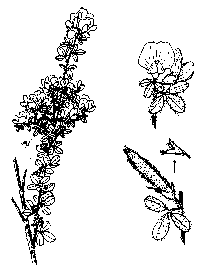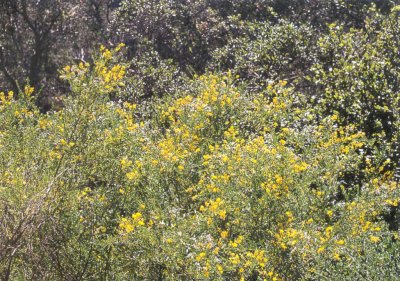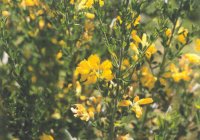|
Genista monspessulana
|
|
|
|
Scientific name
|
Genista monspessulana
|
|
Additional name information:
|
(L.) L. Johnson
|
|
Common name
|
French broom, soft broom, canary broom, Montpellier broom
|
|
Synonymous scientific names
|
Cytisus monspessulanus, C. racemosus, C. canariensis, Genista monspessulanus, Teline monspessulana
|
|
Closely related California natives
|
0
|
|
Closely related California non-natives:
|
4
|
|
Listed
|
CalEPPC List A-1,CDFA C
|
|
By:
|
Carla D’Antonio
|
|
Distribution
|
|
HOW DO I RECOGNIZE IT?
Distinctive features:
|
French broom (Genista
monspessulana) is an upright, evergreen shrub, commonly to ten feet tall.
The round stems are covered with silvery, silky hair, and the small leaves are
ususally arranged in groups of three. About eighty-five percent of the
photosynthetic tissue of French broom is in leaf tissue. The small (less than
half-inch) yellow flowers are pea-like and clustered in groups of four to ten.
The mostly inch-long pods are covered with hairs.
This species sometimes is confused with Scotch broom (Cytisus
scoparius), which has pods with hairs only at the seam, green stems that are
five-angled and ridged, flowers that are golden yellow and larger than half an
inch, and only about fifty-five percent of total green tissue as leaves (Bossard
and RejmÌÁnek 1994).
|
|
Description:
|
Flowers: shaped like pea flowers; calyx
silky-hairy, 0.2-0.3 in (5-7 mm); banner 0.3-0.5 in (10-15 mm), corolla yellow
to light yellow. Fruit: a pod, 0.5-1 in (15-25 mm), covered in dense silky
hairs, dark brown or black at maturity. Empty seed pods curled. Seeds: 3-8 seeds
per pod, brown to black, shiny, round to oval, with a cream to yellow eliaosome
(description from Hickman 1993 and pers. observation).
åÊ
|
|
WHERE WOULD I FIND IT?
|
French broom is found primarily in central
coastal counties from Monterey County north to Mendocino County and inland in
Lake, Solano, and Contra Costa counties. It is also known from Del Norte County,
northern Sierra Nevada foothill counties to 800 meters, and in Kern, San
Bernardino, and San Diego counties.
This broom is common on coastal plains, mountain slopes, and in
disturbed places such as river banks, road cuts, and forest clearcuts, but it
can colonize grassland and open canopy forest. It is found growing in varied
soil moisture conditions, but prefers siliceous soils. Unlike other broom
species in California, it grows reasonably well on alkaline soils with pH 8. It
is competitive in low-fertility soils because of mutualistic relationships with
nitrogen-fixing bacteria found in small nodules on roots. While Scotch broom is
a problem species in many parts of the world, French broom is especially
problematic in California and Australia (Partridge 1989, Parsons 1992). French
broom seedlings are less tolerant of frost than are those of Scotch broom and
consequently are less often found at higher elevations.
åÊ
|
|
WHERE DID IT COME FROM AND HOW IS IT SPREAD?
|
Native to countries surrounding the
Mediterranean and in the Azores, French broom is thought to have been introduced
to the San Francisco Bay Area in the mid-1800s as an ornamental. It spreads via
prodigious seed production. A medium-sized shrub can produce over 8,000 seeds a
year (Bossard unpubl. data). After pods open explosively, flinging seeds up to 4
m, the seeds are further dispersed by ants, birds, and animals and in river
water and rain wash (McClintock, pers. observation), in mud, and on road grading
or maintenance machinery (Parsons 1992). It resprouts readily from the root
crown after cutting, freezing, and sometimes after fire (Bossard et al.
1995).
åÊ
|
|
WHAT PROBLEMS DOES IT CAUSE?
|
French broom currently occupies
approximately 100,000 acres in California (D. Barbe, pers. comm.). It displaces
native plant and forage species, and makes reforestation difficult. It is a
strong competitor and can dominate a plant community, forming dense monospecific
stands. In an experiment in New Zealand French broom had a higher growth rate
than any other broom species found in California, reaching an average height of
more than 4.5 feet (141 cm) in two growing seasons. Since it can grow more
rapidly than most trees used in forestry, it shades out tree seedlings in areas
that are revegetated after harvest.
French broom foliage and seeds are toxic, containing a variety
of quinolizidine alkaloids, especially in young leaves (Montlor et al. 1990). In
some livestock, ingestion of plant parts can cause staggering followed by
paralysis (McClintock 1985). Foliage can cause digestive disorders in horses
(Parsons 1992). Infestations of broom degrade the quality of habitat for
wildlife by displacing native forage species and changing microclimate
conditions at soil levels. French broom is believed to be responsible for
reducing arthropod populations by one-third in Golden Gate National Recreation
Area (Lanford and Nelson 1992). It burns readily and carries fire to the tree
canopy layer, increasing both the frequency and intensity of fires. French broom
along roadsides obstructs views, requiring expensive ongoing road maintenance.
This species establishes a dense, long-lived seedbank, making it difficult to
eradicate.
åÊ
|
|
HOW DOES IT GROW AND REPRODUCE?
|
French broom becomes reproductive at two to three years of age, on reaching a height of one and a half to two feet (45-60 cm). It flowers in late March-May inland, March-July on the coast. Flowers appear just prior to new leaves. Long-lived seeds are copiously produced (Hoshovsky 1995) and mature in June-July. Seeds are known to survive at least five years in soil (Bossard unpubl. data). French broom seedbanks have been found to contain 465 to 6,733 seeds per square meter (Hoskings 1994, Parker and Kershner 1989). Seeds germinate December-July (Bossard unpubl. data). Cheng (in press) reports that heat treating seeds with temperatures of 65 degrees C improved germination of seed in some populations but not in others. Seedlings can tolerate up to 80 percent shade (Bossard unpubl. data). Plants can resprout from the root crown after cutting. Once seedlings are taller than approximately eight inches (20 cm), their rate of resprouting after cutting can be over 90 percent, particularly if cut in the rainy season (Bossard unpubl. data).
|
The period of most rapid vegetative growth is April-July. As in other brooms, most photosynthate is moving up in the shrub toward branch tips during flowering, bud break, and seed set. Photosynthate starts moving down toward roots of this broom after seeds are well grown but before seed release (Bossard et al. 1995). French broom retains much of its foliage in coastal areas, and is more deciduous in inland areas. Its life span is typically ten to fifteen years (Waloff, pers. comm.).
|
(click on photos to view larger image)
|
|
|
HOW CAN I GET RID OF IT?
|
As with other broom species, the best
method for removal of a French broom infestation depends on climate and
topography, age and size of the infestation, importance of impact to non-target
species, and type, quantity, and duration of resources available to remove and
control broom at the site. All methods require appropriate timing and follow-up
monitoring. Because of the seedbank, monitoring removal sites to locate and kill
new seedlings is essential. Location and retreatment of resprouts is also
necessary. Sites should be examined once a year, when the seed germination
period ends in late spring, for five to ten years and every two years
thereafter.
åÊ
|
|
Physical control:
|
Manual/mechanical removal: In general, when using hand removal
or mechanical methods it is best to start in areas with small infestations and
many desirable species that will reseed naturally. Desirable species should be
given some assistance by hand weeding of French broom. Next work on areas with
an intermediate degree of infestation (Fuller and Barbe 1985). Finally, tackle
larger areas and dense concentrations of French broom using other techniques
(fire, chemicals) to augment or replace hand pulling.
Pulling with weed wrenches is effective for broom removal in
small infestations or where an inexpensive, long-duration labor source is
dedicated to broom removal. The weed wrench removes the entire mature shrub,
eliminating resprouting. However, the resultant soil disturbance tends to
increase depth of the seedbank and prolong the need for monitoring. Wrench
removal is labor-intensive, but can be used on slopes. It also allows targeting
of broom plants while minimizing impact on neighboring species. Golden Gate
National Recreation Area has had success in using volunteers to remove broom
with weed wrenches and closely monitoring and removing broom seedlings for five
to ten subsequent years.
Brush hogs, which twist off above-ground plant material, can be
used for broom removal. Although less labor-intensive than weed wrenches, they
damage neighboring species and cannot be used on steep slopes. The twisting
action is more destructive to tissues that initiate resprouting than is clean
cutting. However, depending on the season of brush hog removal, resprouting can
still be a problem. Brush hog removal has been used with limited success in
Redwood National Park (Popenoe, pers. comm.).
Saw cutting: Archbald (1996) reported success with saw and/or
brush cutter following four steps: (1) cut shrubs at or below ground level in
late July or August, after broom has gone to seed and soil moisture is at a
seasonal low; (2) move cut broom plants to sites appropriate for disposal or
burn in spring after plants dry (use tarps to avoid spreading mature seed to
uninfested areas while moving sawed broom); (3) the following summer, after
grasses are dry and have dispersed their seed, destroy new French broom
seedlings by mowing as low to the ground as possible with a heavy-duty brush
cutter with a four-pointed metal blade; and (4) repeat for the next five or six
seasons or until the seedbank is exhausted. Timing and height of cutting are
critical in using this technique. Cutting French broom in June in Mendocino
County at 5-8 cm above soil surface resulted in extensive resprouting (Bossard
et al. 1995).
Mulching: A 10 cm deep wood bark mulch significantly decreased
seedling emergence of French broom in experiments conducted by Cheng (in press)
in the San Francisco Bay Area. This suggests that mulching could be used to
suppress regrowth from the seedbank after removal of mature shrubs.
Prescribed burning: Using fire to remove uncut French broom in
late spring or early summer has had some success at Mt. Tamalpais State Park in
Marin County (Boyd 1994). Reburning of the removal site is usually necessary two
and four years after the initial burn (Boyd, pers. comm.). Reburnings are most
effective in killing resprouts and seedlings if there are either naturally
occurring or reseeded grasses to carry the fire.
Ken Moore (pers. comm.
1999) reports that California State Parks has been very successful (100 percent
mortality) using a propane torch to remove French broom seedlings up to 20 cm in
height that emerge from the seedbank after removal of adult brooms. The torch is
set so it is hot but not flaming and it is passed over the French broom
seedlings. The heat does not cause the seedling to burn but within a day the
seedling is wilted and dead. This is done at the end of the rainy season when
seedlings are up but there is no fire danger. Flame throwers have been used to
spot-treat road edges or small areas with seedlings emerged from the seedbank
after removal of mature brooms in Redwood National Park and in New Zealand
(Popenoe, pers. comm., Johnson 1982). For prescribed burning of pretreated or
cut broom see below under integrated methods.
åÊ
|
|
Biological control:
|
There are no USDA approved biocontrol
agents for French broom. The distribution and effects of the native pyralid
moth, Uresiphita reversalis, on French broom were investigated by
Montllor et al. (1990). While this insect may defoliate some French broom
shrubs, plants grow new leaves after the larval stages undergo metamorphosis.
Other insect biocontrol agents are being tested in England and France for use on
Scotch broom in Australia and New Zealand (Paynter 1997). Some of these agents
may use French broom as a host as well. However, the insects known to feed on
and impact mature Scotch and French brooms (some Sitona sp.) are likely
to feed on Lupinus species as well and consequently would not be
appropriate for release in California (Paynter 1997).
Grazing: Heavy grazing by goats for four or five years during
the growing season has been reported as effective in New Zealand and has been
tried at a few sites in Marin County in California (Archbald, pers. comm.). The
disadvantage is that goats are not selective, and native species that may start
to revegetate the area are also eaten.
åÊ
|
|
Chemical control:
|
A solution of 3 percent glyphosate sprayed
on foliage until wet has been used to treat mature French broom shrubs. Adding
surfactant improved effectiveness (Parsons 1992). However, the foliar spray
impacts non-target species, and resprouting often occurs. Triclopyr ester (25
percent), in Hastenå¨ or Penevatorå¨ oil (75 percent) in one spot, low-volume
basal bark application with a wick has proved effective in killing French broom
(Bossard et al. 1995). Dye should be added to the herbicide solution to help
avoid missing stems. It was necessary to spot only the main stem with 2 or 3
drops of herbicide, within 8 cm of the ground surface, to obtain a 99 percent
kill of the eight-year-old French broom plants in this experiment conducted in
Mendocino County. Soil analyses showed no contamination by the triclopyr, even
in plots that were later burned. However, killing the mature shrubs was not
sufficient to remove the infestation of French broom because of its well
developed seedbank (Bossard et al. 1995). This application technique does not
impact non-target species, but it is time-consuming if the site is large. Both
of these chemical methods should be used during periods of active growth after
flower formation and seed set but before seed dehisces.
The herbicide 2,4-D, alone or with additives such as diquat,
picloram, dicamba, and sodium chlorate, has been used to control French broom.
Not all of these herbicides are registered for use in California. French broom
seedlings are least resistant to auxin-minimizing herbicides such as 2,4-D at
the four- to six-inch (10-15 cm) size. Chemical removal alone results in
standing dead biomass, which makes monitoring for and treatment of broom
seedlings difficult. Standing dead biomass also presents a fire hazard.
åÊ
|
|
An integrated approach
|
The most effective removal treatments in a
project in Jackson State Demonstration Forest conducted by the CalEPPC broom
committee (Bossard et al. 1995) was a combination of treatments that began in
early July with low-volume basal bark application of triclopyr ester (as
Garlonå¨) (25 percent) in Hasten or Penevator oil (75 percent) and a purple dye
in a low-volume basal bark application (2-3 drops in one spot <8 cm from the
soil surface) with a squirt bottle on mature dense stands of French broom. After
four weeks all broom shrubs were dead and were cut down, left on site, and
burned. This flushed the seed from the seedbank by increasing germination rate
with the next rains. French broom seedbanks in burned plots were reduced to less
than 5 percent of their original size three years after prescribed burns.
Seedbanks of unburned plots otherwise treated the same were reduced to 15.5
percent of their original size, and control plots exhibited no significant
decrease in seedbank size. For the next two years, in July, seedlings in plots
were treated with either 2 percent glyphosate (as Roundupå¨, label-recommended
strength) or cut with a four-blade gasoline powered brush cutter. Glyphosate was
applied with a backpack sprayer, and non-target vegetation was avoided.
Brush-cut plots had 1.6 resprouts per square meter, whereas plots in which
glyphosate was applied to seedlings had 0.2 resprouts per square meter. Mean
percent cover by French broom was reduced from 87 percent to less than 0.2
percent in plots treated with basal bark triclopyr, cut, burned, and seedlings
treated with glyphosate.
åÊ
|




